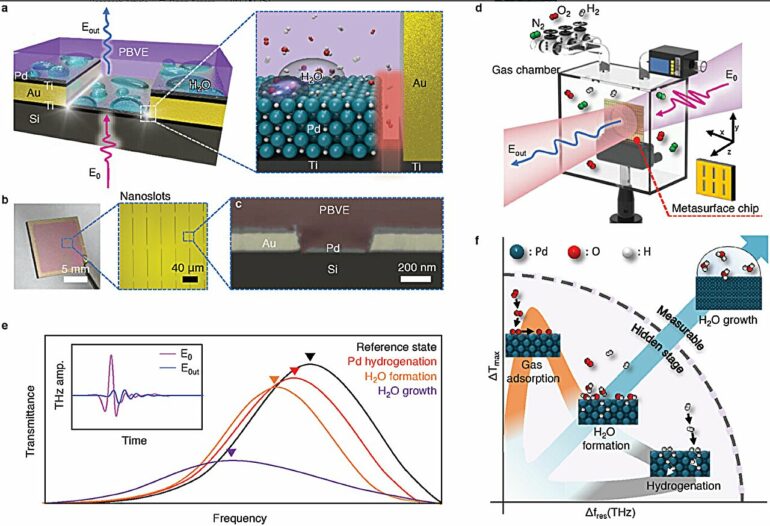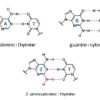Hydrogen gas is the smallest and lightest of all known molecules, and its colorless and odorless nature makes it easy to leak. Also, when concentrated above 4% in a confined space, it poses a risk of ignition or explosion.
In order for hydrogen to become a major player in the future energy industry, it is essential to ensure safety via ultra-sensitive gas detection technology across all elements of gas-dealing processes, such as gas production, storage, and transportation. However, conventional gas-leakage sensors using electric signals are prone to yield electrical sparks, which can cause an explosion of leaked hydrogen gas.
In addition, the mainstream electrode-based contact sensors affect the effective signal stability depending on the device’s contact state showing weak signal fidelity. Thus, it is desirable for achieving stable, non-explosive via non-contact mode detection to remove any possible dangers to develop a secure device that does not lead to disaster situations.
A Korea Institute of Science and Technology (KIST) team, led by Dr. Minah Seo of the Sensor Systems Research Center & KU-KIST Graduate School and Prof. Yong-Sang Ryu of School of Biomedical Engineering, College of Health Sciences, Korea University, has developed a non-contact terahertz light sensor. This can detect hydrogen gas leaks as small as 0.25% in real-world environments at room temperature and pressure, which is the global top level of limit-of-detection performance via optical detection methods.
The work has been published in the journal Advanced Materials.
Spectroscopy is a non-contact observation method of measuring changes in the value of optical constants of an analytic sample. In this method, changes in the reacting substance are observed non-invasively, by measuring variations in the optical properties when the reacting substance encounters hydrogen gas.
Terahertz electromagnetic waves have a very wide frequency band, which makes them sensitive to the natural vibrations of gas molecules, and can be utilized in spectroscopy to resolve minute unique information and differences in molecules such as various gases, DNA, and amino acids. However, due to the low probability of interaction with trace amounts of hydrogen gas and the lack of technology to amplify the signal of terahertz waves, it has been difficult to utilize them in practice.
The research team focused on the property of hydrogen permeating into palladium metal, and devised a research strategy to address this through the interaction of light and matter. The researchers developed a gas-detection sensing platform that can sensitively measure changes in terahertz optical signals caused by trace amounts of gas, using metamaterials that have the ability to amplify signals in specific bands of electromagnetic waves.
The team first developed a terahertz metamaterial that can amplify signals in the gas-sensitive terahertz band, and then uniformly applied palladium to the metamaterial to create an extremely narrow 14-nm space to maximize the sensitivity of the terahertz signal.
The palladium plays bifunctional roles in not only the catalytic reaction of adsorbed hydrogen and oxygen to produce water molecules on the surface, but also in the hydrogen storage. For mimicry of real-world environments (80% of nitrogen, 20% of oxygen), hydrogen and oxygen gases were then injected into the developed sensing chamber and exposed to the terahertz sensing platform.
The results showed great responsibility with respect to exposed hydrogen gas via significant optical signal variation, and these were scientifically analyzed in a real-time fashion. The usage of ultra-thin palladium together with ultra-sensitive optical band width (the terahertz) provided synergetic performance enabling the researchers to detect under 1% of hydrogen gas leakage at the real-time detection level.
Not only the superior detection performance, but also the reusability of the detection platforms was considered during the platform designing process.
In general, metal hydrides such as palladium are difficult to reuse because they are irreversible, meaning they cannot return to their original state after a phase change, but the KIST-Korea University research team secured the reusability of the sample through special processing technology. They also succeeded in developing a technology to contactlessly track the mechanism of hydrogen desorption at the nanometer scale in real-time through optical signals.
“Existing light sensors have very limited reliability in normal temperature, pressure, and humidity environments, but this is a promising technology that can detect and screen not only gases but also various biochemical substances in extremely small amounts by dramatically increasing sensitivity,” said Dr. Minah Seo, lead author of the study.
“It is expected to be used to develop a system that can immediately respond to various harmful factors, gases, and diseases through mobile, on-site, and real-time inspections.”
“In addition to the terahertz measurement technology, it has opened up the possibility of visually checking various gas adsorption and desorption processes and molecular-level chemical reaction mechanisms occurring on metal surfaces,” said Professor Ryu Yong-sang of Korea University, lead author of the study.
More information:
Jinwoo Lee et al, Advancements of Intense Terahertz Field Focusing on Metallic Nanoarchitectures for Monitoring Hidden Interatomic Gas‐Matter Interactions, Advanced Materials (2023). DOI: 10.1002/adma.202308975
Provided by
National Research Council of Science and Technology
Citation:
Development of real-time trace hydrogen gas leakage via a novel terahertz-wave optical platform (2024, January 25)



